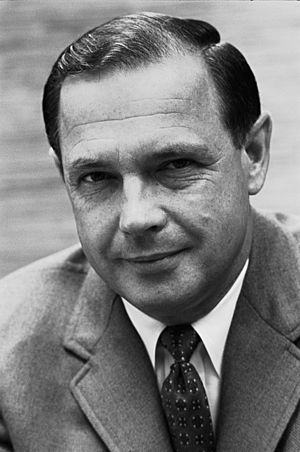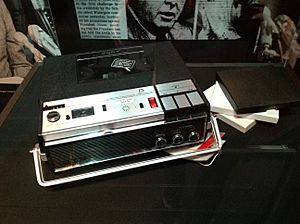Alexander Butterfield facts for kids
Quick facts for kids
Alexander Butterfield
|
|
|---|---|

Butterfield in 1969
|
|
| 5th Administrator of the Federal Aviation Administration | |
| In office March 14, 1973 – March 31, 1975 |
|
| President | Richard Nixon Gerald Ford |
| Preceded by | John H. Shaffer |
| Succeeded by | John L. McLucas |
| Personal details | |
| Born |
Alexander Porter Butterfield
April 6, 1926 Pensacola, Florida, U.S. |
| Education | University of Maryland, College Park (BS) George Washington University (MS) University of California, San Diego (MA) |
| Military service | |
| Allegiance | |
| Branch/service | |
| Years of service | 1948–1969 |
| Rank | Colonel |
| Battles/wars | Vietnam War |
| Awards | Distinguished Flying Cross |
Alexander Porter Butterfield (born April 6, 1926) is a retired officer from the United States Air Force. He also worked as a public official and businessman. He was a special assistant to President Richard Nixon from 1969 to 1973.
Butterfield became well-known on July 13, 1973. He revealed that there was a secret taping system in the White House. This happened during the investigation into the Watergate scandal. He was not involved in the scandal itself, only in revealing the tapes. From 1973 to 1975, he led the Federal Aviation Administration (FAA). The FAA is in charge of air travel safety in the U.S.
Contents
Early Life and Air Force Career
Alexander Butterfield was born on April 6, 1926, in Pensacola, Florida. His father was a United States Navy pilot. Alexander grew up in Coronado, California.
He started college at the University of California, Los Angeles. There, he became friends with H. R. Haldeman and John Ehrlichman. In 1948, he left college to join the United States Air Force.
Military Service and Achievements
Butterfield first served as a fighter pilot instructor in Las Vegas. Later, he moved to West Germany in 1951. He was part of the Skyblazers jet fighter acrobatic team. He also commanded a fighter squadron in Japan.
During the Vietnam War, Butterfield led a squadron of reconnaissance aircraft. These planes flew low to gather information. He flew 98 combat missions. For his bravery, he received the Distinguished Flying Cross.
He also worked at the White House for a time in 1965 and 1966. This gave him experience in government. He reached the rank of colonel. Before retiring from the Air Force, he worked in Australia.
Education During Service
While in the military, Butterfield continued his education. He earned a bachelor's degree from the University of Maryland, College Park in 1956. He also received a master's degree from George Washington University in 1967.
Working at the White House
How He Joined the White House Staff
In late 1968, Butterfield learned he would stay in Australia for two more years. This would delay his promotion in the military. He wanted to be where important things were happening.
He saw a newspaper article about H. R. Haldeman becoming President Nixon's White House Chief of Staff. Butterfield wrote to Haldeman asking for a job. They met in New York City in December 1968. Haldeman offered him a job as his deputy, or main assistant. Butterfield retired from the Air Force a few days later. His new role as deputy assistant to the president was announced on January 23, 1969.
His Role as Deputy Assistant
As deputy assistant, Butterfield was Haldeman's main helper. He met with President Nixon and Haldeman every day. They planned the next day's activities. He controlled what paperwork Nixon saw. He also kept a log of all memos.
Butterfield traveled with Haldeman on all trips within the U.S. He also managed the White House staff when Nixon and Haldeman were on foreign trips. He made sure that all meetings Nixon attended had "talking points" ready. He also made sure summaries were written after each meeting.
He also oversaw all FBI checks requested by the White House. These included routine background checks for new employees. Butterfield knew a lot about Nixon's daily work. He knew what Nixon read and who he met.
Butterfield also managed people who met with Nixon. He made sure they arrived on time and did not stay too long. He also helped manage President Nixon's relationship with his wife, Pat Nixon.
Setting Up the Taping System
Butterfield also supervised the installation of the secret taping system in the White House. President Nixon wanted this system to record conversations. On February 10, 1971, Nixon's assistant, Lawrence Higby, told Butterfield about the plan. Nixon wanted a voice-activated system in the Oval Office and on White House phones. He said it was to create a more accurate record.
Butterfield worked with the Secret Service to install hidden microphones. Five were in Nixon's desk in the Oval Office. Two were in lamps over the fireplace. Two more were in the Cabinet Room. All telephone lines in the Lincoln Sitting Room and Oval Office were also taped. Butterfield said only Nixon, Haldeman, Higby, and a few Secret Service staff knew about it. In April 1971, Nixon also had the system installed in his private office.
Leaving the White House
In March 1973, Butterfield was approved to become the administrator of the Federal Aviation Administration. He then left his job at the White House.
Revealing the Taping System
How the Tapes Were Discovered
John Dean testified in June 1973 that he thought White House conversations were taped. Staff from the United States Senate Watergate Committee started asking witnesses about any taping systems.
The White House provided a document to the committee. This document had exact quotes from Nixon's meetings with Dean. A committee investigator, Scott Armstrong, realized these quotes suggested a taping system existed.
Questioning on July 13
On July 13, 1973, Butterfield was interviewed by Senate Watergate Committee staff. He was questioned because he was Haldeman's top assistant. He knew a lot about the president's daily activities.
Donald Sanders, a committee lawyer, asked Butterfield about the quotes in the White House document. Butterfield said they were too detailed to be from notes. He also said Nixon and his staff did not take notes of private meetings. When asked where the quotes might have come from, Butterfield said he did not know.
Then, Sanders asked if John Dean's idea about White House conversations being taped was true. Butterfield replied, "I was wondering if someone would ask that. There is tape in the Oval Office." He then explained when the system was installed and how it worked. He said, "Everything was taped... as long as the President was in attendance."
Everyone present understood how important this information was. It changed the entire Watergate investigation. Butterfield's interview lasted for several hours. The investigators agreed to keep it a secret for a short time. The committee chairman, Senator Sam Ervin, quickly asked Butterfield to testify publicly on July 16.
Public Testimony on July 16
On July 16, Butterfield testified publicly. His testimony was shown live on major television networks. He confirmed the existence of the secret taping system. His testimony lasted only 30 minutes.
News outlets called his testimony "dramatic." Historians say it "electrified Washington." It also started a major constitutional crisis. Within hours of Butterfield's testimony, the taping system was removed from the White House.
After Watergate
His Role in Watergate Events
Butterfield was not involved in the Watergate cover-up. He was never accused of any crimes related to it.
He did play a small part in some events. Nixon had campaign money left over from 1968. Some of this money was used for illegal activities related to Watergate. Haldeman kept $350,000 in cash in a briefcase. This money was later moved to the White House. Haldeman asked Butterfield to handle this cash. Butterfield gave it to a friend to keep in a safe deposit box. He told investigators about his role in this when he left the White House in 1973.
Butterfield also had a very limited role in some surveillance. In September 1972, Nixon wanted to keep an eye on Senator Edward M. Kennedy. Butterfield assigned a former bodyguard to be a spy in Kennedy's security team.
Leading the Federal Aviation Administration
By late 1972, Butterfield felt his job at the White House was no longer challenging. He told President Nixon he wanted to leave. Nixon offered him a position at the Federal Aviation Administration (FAA). Butterfield accepted.
On December 19, 1972, President Nixon nominated Butterfield to lead the FAA. However, federal law required the FAA Administrator to be a civilian. Butterfield was a retired military officer. So, in February 1973, Butterfield resigned from the Air Force Reserves. This meant he gave up his military pension. Nixon then re-nominated him. Butterfield was confirmed on March 12, 1973. He officially left his White House job on March 14.
In early 1975, President Gerald Ford asked for the resignations of many officials from the Nixon administration. Butterfield was among them. He resigned on March 25, 1975, and left the government on March 31, 1975.
Life After Government Service
After leaving the government, Butterfield found it hard to find a job for two years. He eventually worked for a flight service company in San Francisco, California. Later, he worked for a financial company in Los Angeles. He then started his own business consulting firm. He retired in 1995. ..... This was a secret source for the Watergate investigation. He said in 1995, "I think it was a guy named Mark Felt." Felt's identity was revealed in 2005.
Butterfield was a main source for Bob Woodward's 2015 book, The Last of the President's Men. Butterfield kept many important records from his time at the White House.
In July 2022, Butterfield appeared on the MSNBC show, The Last Word.
Cassidy Hutchinson, a former aide in the Trump administration, testified to the January 6 Committee. She said she was inspired by Butterfield's example. She decided to testify fully and truthfully, even under pressure. Butterfield said Hutchinson would inspire other young people. He asked her to promise to help others in similar situations in the future.
Personal Life
Butterfield married Charlotte Maguire in 1949. They divorced in 1985.
In 1992, Butterfield moved to La Jolla, California. He was a close friend of Audrey Geisel, the wife of children's book author Theodor "Dr. Seuss" Geisel. He went back to school and earned a master's degree in history from the University of California, San Diego. As of November 2015, he was working on a Ph.D. in history. His focus was on the president's power to pardon. As of 2016, he was still active on the boards of several companies.
Images for kids







